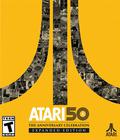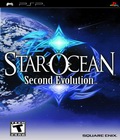Genre: Role-Playing
Publisher: Square Enix
Developer: Square Enix
Release Date: January 20, 2009
Lately, Square Enix has been on a bit of a nostalgia trip, re-releasing a series of the company's older games on handhelds in an attempt to drum up some extra business. While most Square Enix fans are currently most interested in a certain game that starts with the words Final Fantasy and ends with the number 13, there have also been a fair number of remakes released to hold gamers over until that title's release sometime in the year 3000. The latest in the lineup is Star Ocean: Second Evolution for the PSP, and while it nails the experience of the original, old flaws like shoddy animation and boring battles have even this new title showing its age.
Second Evolution is a retelling of Star Ocean: The Second Story, which was originally released on the PS1. The story revolves around Claude C. Kenny, a young interstellar naval officer transported to a strange new world during a scouting mission gone awry, and Rena, a teenage girl whose strange magical powers make her unique among all the denizens of her planet. Claude and Rena meet when he is transported near Rena's village and saves her from a monster attack. This being an RPG, she mistakes him for the mythical Hero of Light, who is to save the world from an impending cataclysm. Claude, perhaps being a bit too polite for his own good, agrees to help out as best he can, even though he spends the majority of the game with no real connection to the planet he finds himself on or the plight of its people. Unfortunately, by the time Claude is given a true reason to fight the good fight, many will likely have given up on the plodding, convoluted story and just be cruising on autopilot, skipping over dialogue boxes in favor of getting back to the action.
One thing that sets this game apart from many others, though, is the fact that at the very beginning, gamers are asked to choose either Claude or Rena as their main character, and that choice significantly impacts the entire experience. Certain cut scenes and story events are different depending on which character you follow, and even some party members are exclusive to one version of the story or another. For this reason alone, the game gives you a significant incentive to play through at least twice, or you'll miss out on a lot.
When Star Ocean: The Second Story was originally released, there was much ado about the newfound freedom the game offered in both combat and customization. That freedom has been brought over into Second Evolution virtually untouched, both for better and for worse.
One aspect of the game that has withstood the test of time is Second Evolution's skill system. Whenever a character levels up, he gains not only experience points, but skill points as well. These points can be dumped into any one of dozens of categories, allowing players to spec their party in just about any way they see fit. Some skills directly affect battle by improving your character's chances of ignoring a baddie's defense while attacking or avoiding an enemy's blow; while others are utilized for item creation and upgrading. For instance, when a character reaches a certain level in a number of different skills, that person is granted a specialty. Those with a specialty in cooking can use ingredients to make dishes with a variety of effects, while characters well-versed in compounding can combine weapons and minerals to create newer, stronger weapons. Even better, when a number of party members have a high enough level of the same skill, players earn group specialties, which can affect things like the frequency of enemy encounters and even the ability to summon a giant bunny to hop you around the map so you can get to the next destination quickly. Overall, it is a system that worked great the first time around, and it's nice to see it back here in its original glory once more.
While the return of the original skill system is nice, the appearance of Second Story's combat is not. The game was known for being one of the progenitors of real-time battle, but just because you are among the first to do something doesn't mean that you're among the best. Combat was and is an incredibly boring affair, with players being tasked with doing little more than mashing the X button until it's all over. Sure, there are special skills that can be mapped to the PSP's shoulder buttons, but the boss fights or particularly tough foes that require them are so rare that many are likely to forget they even exist. Further muddling things up is the fact that every spell cast has a five- to 10-second unskippable animation, leading to incredibly slow, drawn-out combat. Just when things seem to be flowing, it's all interrupted for an annoying scene that can't be skipped over or turned off in any way. If you should be so unfortunate as to partake in a battle with a number of magic wielders at once, then feel free to just put down the PSP and grab a snack because chances are that you won't miss anything while you're gone. It's unfortunate that Square Enix never bothered to clean this up because it was a problem with the original game, and it continues to be a problem here.
The title's visuals are a mixed bag as well, with some brilliant anime animation being horribly marred by ugly, out-of-date sprites. One of the few genuine upgrades Second Evolution has seen is that the entire vocal cast has been replaced (thankfully), and the team has included a handful of animated cut scenes to show off the PSP's prowess. These scenes are beautiful, and when they show up, they do a great job of further pulling gamers into Claude and Rena's adventure. The problem is that these scenes are rare, only showing up for the biggest of the big moments, and the rest of the time, we are stuck with low-rent, low-quality sprites that absolutely pale in comparison. Since these scenes are the ones used to convey most of the game's more emotional moments, a lot of the impact is lost looking at these ugly little characters. Thus, a great deal of storytelling potential is lost.
Star Ocean: Second Evolution for the PSP will almost invariably appeal to nostalgia gamers and those who retain fond memories of Star Ocean from all those years ago. Sadly, those memories may easily cloud good judgment, as this game has clearly been left behind in the interceding years. The combat is tedious and boring, the visuals are bland and ugly, and I can't remember the last game I played where so many words were spoken and yet so little of substantive importance was said. If you played and enjoyed the original, then Second Evolution is a great blast from the past; if you haven't, there are modern RPGs that do almost everything this game does — only much, much better.
Score: 7.7/10
More articles about Star Ocean: Second Evolution











 Space Date 366: A young Federation officer finds himself transported to a mystical planet, where he is suddenly anointed as the Hero of Light. He begins a journey to fulfill a prophecy and save a newfound race. Star Ocean: Second Evolution continues the Star Ocean saga!
Space Date 366: A young Federation officer finds himself transported to a mystical planet, where he is suddenly anointed as the Hero of Light. He begins a journey to fulfill a prophecy and save a newfound race. Star Ocean: Second Evolution continues the Star Ocean saga!


























